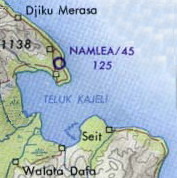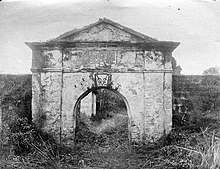Buru
 | |
 | |
| Geography | |
|---|---|
| Location | Oceania |
| Coordinates | 3°24′S 126°40′E / 3.400°S 126.667°E |
| Archipelago | Maluku Islands |
| Area | 9,505 km2 (3,670 sq mi) |
| Highest elevation | 2,428 m (7966 ft) |
| Highest point | Mount Kapalatmada |
| Administration | |
Indonesia | |
| Province | Maluku |
| Regencies | Buru, South Buru |
| Demographics | |
| Population | 186,779 (2015 Census) |
| Pop. density | 19.65/km2 (50.89/sq mi) |
| Ethnic groups | Buru, Lisela, Ambelau, Kayeli |
| Additional information | |
| Time zone | |
Buru is an island in Indonesia. About a third of the people are indigenous, mostly Buru, but also Lisela, Ambelau and Kayeli people. Between 1658 and 1942, Buru was colonised by the Dutch East India Company and then by the Crown of the Netherlands. The Japanese army had the island between 1942 and 1945. In 1950, it became part of independent Indonesia. During president Suharto's New Order administration in the 1960s–1970s, Buru was a prison for thousands of political prisoners. The famous Indonesian writer Pramoedya Ananta Toer wrote most of his novels, including Buru Quartet in that prison.
Geography and geology[change | change source]


Buru island is between two seas of the Pacific Ocean – Seram Sea (Indonesian: Laut Seram) on the north and Banda Sea (Indonesian: Laut Banda) to the south and west. To the east, is the Manipa Strait (Indonesian: Selat Manipa) then Seram Island (Indonesian: Pulau Seram). The area of Buru is 9,505 km2 (3,670 sq mi).[1] Buru is the third largest Maluku Islands.
Buru is shaped like an oval. It is about 130 km (81 mi) from east to west and 90 km (56 mi) from north to south. The highest point on the island (2,700 m (8,900 ft)[2]) is the peak of Mount Kapalatmada. The island is mostly mountainous, especially in the central and western parts. Much of the island is covered with tropical rain forest.[3]
Plants and animals[change | change source]

Buru is between Australia and Asia. Its plants and animals are unique.
Administrative division[change | change source]
The island belongs to the Indonesian province of Maluku (Indonesian: Propinsi Maluku). It is split into Buru Regency (Indonesian: Kabupaten Buru) and South Buru Regency (Indonesian: Kabupaten Buru Selatan).[4]
Population[change | change source]
As of the 2010 Census, the population of the islands administered as Buru was 161,828 people;[5] at the 2015 Intermediate Census this rose to 186,779. About 68.3% in the northern regency and 31.7% in the southern;[6]
History[change | change source]
Precolonial period[change | change source]
One of the first mentions of Buru is in the Nagarakretagama in 1365. That is an Old Javanese funeral speech for Hayam Wuruk, the ruler of the Majapahit Kingdom.[7][7][8]
In the 16th–17th centuries Buru was claimed by the rulers of Ternate island and by the Portuguese. But neither nation controlled the island. They only visited it for trade. Makassar people from Sulawesi island built fortifications on Buru. The Makassars forced the locals to grow valuable spices, such as clove.[9]
Colonial period[change | change source]



The Makassars and Dutch East India Company both wanted the spices in the east of the Malay archipelago. They fought a war. In 1648, the Dutch forced the Makassar out of Buru. The Dutch destroyed farms and buildings because they could not stay on Buru and afraid that the Makassars might come back.[9] They came back with with four cannon and staffed by 24 soldiers in 1658 at the southern coast of Kayeli Bay. They built a permanent settlement and fortress. The Dutch forced about 2,000 local island people to move to Kayeli Bay. Many of them were nobles. The Dutch wanted to control the local people and make them work in the clove fields.[9] These local Kayeli people became important leaders.[9]
The Dutch East India Company ended in the early 18th century. All its land in the Malay archipelago became property of the Dutch crown.[9] Buru was divided into regencies. Local rulers called rajascontrolled the regencies for the Dutch. All rajas were Kayeli tribal nobles.[9][10]
The demise of Kayeli dominance began in the 1880s, when the leaders of Leliali, Wae Sama and Fogi clans moved significant parts of their ethnic groups to their original settlements; they were joined in the early 1900s by Tagalisa. By then, many other of the original 13 Kayeli villages were either abandoned or had lost their rajas. By about 1910, the leading role of the Kayeli clan had almost disappeared.[9]
Transition years 1942–1950[change | change source]
From the spring of 1942 to the summer of 1945, the Japanese army controlled all of the Dutch East Indies, including Buru. The island was bombed by the Allies planes. They were attacking the Namlea Airport.[11]
After Japan lost the war, control of the island went back to the Netherlands. In December 1946, Buru, along with the other Maluku Islands, Sulawesi and Lesser Sunda Islands, was included in a partly independent State of East Indonesia. It was set up by the Dutch government. They planned to let their East Indies slowly become a dependent state. In December 1949, eastern Indonesia joined the Republic of the United States of Indonesia.[12][13][14]
In April 1950, Buru, Ambon, Seram and some smaller nearby islands started an independent Republic of South Moluccas. They promised to keep close political ties with the Netherlands.[12][13] The Republic of Indonesia tried to absorb the RMS by talking. But, this failed. So, the Republic of Indonesia started a six-month war in July 1950. In December 1950, the Republic of Indonesia controlled Buru and it became part of the Republic of Indonesia.[12][13]
As part of Indonesia[change | change source]
Between 1950 and 1965, the new government wanted to make Buru part of Indonesia. In the 1960s and 1970s, during the military regime of General Suharto, Buru became a main prison. Most prisoners were Communists and other left-wing representatives, and intellectuals. Most camps on Buru were closed in 1980. More than 12,000 people had been prisoners. [15][16][17] At least several hundred had died or been killed.[15]
One of the prisoners was an Indonesian writer, Pramoedya Ananta Toer. He was in prison for 14 years (1965–1979). He wrote there many of his novels, including most of Buru Quartet.[16][18] Until 1975, Toer was not allowed pencil or paper. He memorized his novels and told them to his cellmates. They helped him to remember the stories.[15][16][19]
Transportation[change | change source]
Buru is linked with other parts of Indonesia by sea. It has two main ports in Namlea and Namrole. The military airfield at Namlea (runway 750 meters) is used for air transportation.[20] Most local transportation is on roads.
Traditional work and culture[change | change source]


Traditionally, work and culture in villages changed with seasons and people moved to follow work. and food. Men hunted wild pigs called Buru babirusa, deer, and possum. Women gathered wild vegetables. During the west monsoon (November to April) both men and women worked together in the fields. The soil on the island was not good, so sometimes villages moved to newer, better soil. Sometimes people would move their whole village after some 20 years of using one piece of land. Most settlements were small.
Traditional Buru clothes are similar those of most other Indonesia peoples. Men wear sarongs and a long-skirted tunic. Women also wear sarongs but a shorter jacket. Color of clothes is different for the different tribes of the island.[9]
Research[change | change source]
Both Indonesian and foreign scientists study the special plant and animal life on the island. But, the original plants on the coast and much of the mountain forest have been cut or destroyed for farming. Only two large areas rain forest are still in the mountains. These are protected areas called Gunung Kapalat Mada (1,380 km2) and Waeapo (50 km2).[3]
References[change | change source]
- ↑ "Buru". Encyclopædia Britannica Online.
- ↑ "Mountains of the Indonesian Archipelago" Peaklist.org. Listed as "Gunung Kapalatmada". Retrieved 2012-09-24.
- ↑ 3.0 3.1 "Buru rain forests". Terrestrial Ecoregions. World Wildlife Fund.
- ↑ "Undang-Undang Republik Indonesia Nomor 32 Tahun 2008 tentang Pembentukan Pembentukan Kabupaten Buru Selatan di Provinsi Maluku (Indonesian law No. 32 2008 on establishing South Buru Regency)" (PDF) (in Indonesian). LL Sekretariat Negara. Archived from the original (PDF) on 21 July 2011.
- ↑ "Jumlah Penduduk Menurut Kabupaten dan Jenis Kelamin" (PDF) (in Indonesian). Badan Pusat Statistik Provinsi Maluku. Archived from the original (PDF) on 21 July 2011. Retrieved 16 March 2012.
- ↑ Badan Pusat Statistik, Jakarta, 2018.
- ↑ 7.0 7.1 Shaub A.K. (1992). Нагаракертагама как источник по истории раннего Маджапахита (1293—1365) (Nagarakertagama as a source on early Majapahit). Vol. 4. Moscow. pp. 24, 38.
{{cite book}}: CS1 maint: location missing publisher (link) - ↑ Made Yanuarta (16 March 2007). "Kitab Negara Kertagama (terjemahan)" (in Indonesian).
- ↑ 9.0 9.1 9.2 9.3 9.4 9.5 9.6 9.7 Barbara Dix Grimes. "Mapping Buru ..." (PDF). Australian National University.
- ↑ "Sejarah Maluku" (in Indonesian). Official site of Maluku Province. 20 September 2009. Archived from the original on 18 July 2011.
- ↑ "USAAF Chronology". Jack McKillop. 1955. Archived from the original on 2011-08-19. Retrieved 2019-11-30.
- ↑ 12.0 12.1 12.2 Karen Parker, J.D. (March 1996). "Republik Maluku: The Case for Self-determination". Association of Humanitarian Lawyers. Archived from the original on 2011-08-19. Retrieved 2019-11-30.
- ↑ 13.0 13.1 13.2 Всемирная история (World History). Vol. 12. Moscow: Мысль. 1979. p. 359.
- ↑ "Indonesian States 1946–1950". Ben Cahoon.
- ↑ 15.0 15.1 15.2 Thomas Fuller (15 March 2000). "Suharto's Gulag/The Buru Island 'Humanitarian Project' : Former Prisoners Look Back on a Remote Tropical Hell". New York Times.
- ↑ 16.0 16.1 16.2 "The 1995 Ramon Magsaysay Award for Journalism, Literature and Creative Communication Arts". Ramon Magsaysay Award Foundation. 1995. Archived from the original on 25 February 2011. Retrieved 3 November 2010.
- ↑ Max Lane (10 May 2006). "Pramoedya Ananta Toer: Indonesia's greatest novelist". Green Left Weekly. Archived from the original on 6 February 2010.
- ↑ Прамудья Ананта Тур (Pramudja Ananta Tur) (1986). Мир человеческий (World of humans). Moscow: Raduga. pp. 5–8.
- ↑ Vickers, Adrian (2005). A History of Modern Indonesia. New York: Cambridge University Press. p. 53. ISBN 0-521-54262-6.
- ↑ "Bandara Namlea" (in Indonesian). Indonesian Ministry of Transportation. 14 April 2010.
Orther reading[change | change source]
- Grimes, Barbara Dix (1994). Buru inside out. In: Visser, L.E., ed. Halmahera and beyond. Leiden: KITLV Press. pp. 59–78. ISBN 90-6718-072-6.
Other websites[change | change source]
- "Buru rain forests". Terrestrial Ecoregions. World Wildlife Fund.
- Buru's official website (in Bahasa Indonesia)
